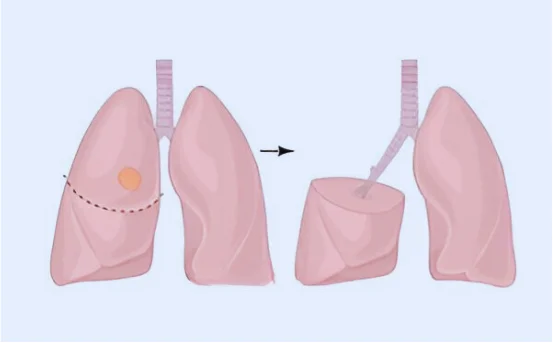The Wedge Resection Surgery is a minimally-invasive procedure which involves the removal of a small wedge-shaped part of an organ or tissue. This most commonly occurs in the lung. This technique is used to treat localized damage, small tumors or infections. The causes for wedge resection surgery is a more conservative option than more invasive surgical procedures like lobectomy and segmentectomy. It preserves more healthy tissue.
What is Wedge Resection?
The wedge resection technique is used to remove non-functional tissue, damaged tissue, or diseased tissue. It can be performed in a triangle or wedge shape. The procedure is commonly used in lung surgery for non-small-cell lung cancer at an early stage. However, it can be performed on any organ, including the liver, kidney or intestines.
The wedge resection falls under the category of non-anatomical surgery, which means that it does not follow natural organ divisions. The normal or affected tissue remains, and the remainder of the organ is left intact.
Why is Wedge Resection Surgery Performed?
The causes for wedge resection surgery include localized damage, small tumors, and infections that affect the organ’s functionality.
There are many reasons that a wedge resection might be required:
- Early-Stage Lung Cancer:- When patients are unable to undergo more invasive surgery, wedge resection can be used to remove localized, small tumors.
- Benign Pulmonary nodules:- When diagnosing pulmonary nodules, wedge resection can be used to remove them and perform a biopsy.
- Infections and Inflammatory Conditions:- A wedge resection is used to remove infected lung tissue or other organs when there are tuberculosis or fungal infections.
- Trauma or Injury:- A wedge resection is used to remove the damaged part of an organ if it has been injured by trauma. This can help prevent complications.
- Metastatic cancer:- Some cases of metastatic cancer that has spread to the liver or lung can be removed using wedge resection.
There are different types of wedge resection surgery
The wedge resection procedure can be classified into different types depending on the organ affected and the condition of the patient. Each type has its own unique benefits and approach.
- Pulmonary Wedge (Lung Resection):- This is the most popular form of wedge resection. This procedure involves the removal of a small wedge-shaped portion of lung that contains an abnormal growth or tumor.
- Open Thoracotomy (OT): This is a traditional method whereby a large incision in the chest is made to reach the lungs.
- Video-Assisted Thoracoscopic (VATS) Surgery: This is a minimally-invasive technique that uses a camera-guided telescope and small incisions.
Recovery is quicker and there are fewer complications.
Robotic-Assisted wedge resection: This technique uses robotic tools to achieve greater precision. It is ideal for difficult-to-reach or complex tumors.
- Liver Wedge Resection :- Used to remove cancerous or benign tumors from the liver. Wedge resection is a great option for localized lesions because the liver regenerates so well. Open Liver Resection (Open Liver Resection): This is a traditional method that involves a large abdominal cut. Laparoscopic liver resection: A minimally invasive technique with small incisions, perfect for tumors located in easily accessible areas.
- Kidney Wedge Resection :- Although rare, wedge resections can be performed to remove small tumors or lesions while maintaining renal function. This is often performed as part of a nephron sparing surgery to treat localized renal mass. Most commonly, laparoscopic or robot-assisted surgery is used.
- Intestinal Wedge Resection :- Often used to remove localized growths and damage in the intestines. Useful for localized Crohn’s disease or early cancer. This is often combined with primary anastomosis.
The Benefits of Wedge Resection Surgical Procedure
- The wedge resection preserves more healthy tissue than anatomical resections.
- Many wedge resections can be performed with minimally invasive techniques.
- Patients recover more quickly than patients who have undergone more complex surgeries.
- Effective for small lesions: Particularly useful in early cancer stages and benign conditions.
Risks and considerations
As with any surgical procedure, wedge resection is not without its risks.
- Bleeding
- Infection
- Air leakage (especially during lung surgery)
- Postoperative pain
- Limitation of efficacy in larger or more aggressive tumors
The procedure is usually recommended to patients who have a small, localized cancer or poor lung reserves that prevent more aggressive surgery.
Recovery after Wedge Resection Surgery
- Hospital Stay:- The average hospital stay is 1-4 days depending on the type and extent of the surgery, as well as the overall health of the patient.
- Pain Management:- Medication is used to manage pain, particularly after open surgery.
- Exercise:- To prevent complications such as blood clots and pneumonia, patients are encouraged to begin walking immediately after surgery.
- Follow-Up:- It is important to have regular imaging and follow up visits in order to monitor the healing process and detect any recurrence of cancer if it was a procedure related.
Conclusion
The wedge resection is an effective and versatile treatment for small and localized abnormalities of organs such as the lungs, liver, kidneys, and intestines. The procedure is now faster and less prone to complications, thanks to the advancements of minimally invasive surgery techniques.
Understanding the different types of wedge resection surgeries and their applications helps patients and healthcare professionals make informed choices about treatment options. Consult a surgeon if you have a diagnosis which may require a wedge resection. They can determine the best treatment based on your health, the organs involved and other factors.























